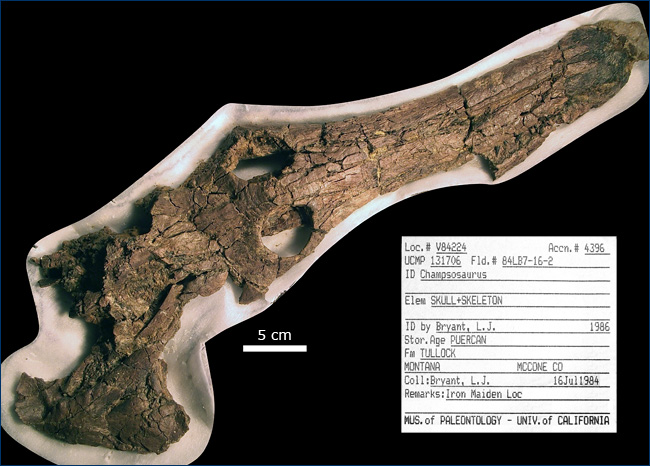[Recent Entries][Archive][Friends][User Info]
| November 4th, 2013 | |
|---|---|
| 07:24 pm [industrialterro] [Link] |
Champsosaurus Хампсозавры (Champsosaurus) — род вымерших рептилий группы диапсид отряда Choristodera. В длину хампсозавр был примерно 1,5 метра, хотя C. gigas, самый крупный вид рода, достигал длины 3—3,5 м. Считается, что хампсозавр внешне напоминал гавиала и, подобно гавиалу, охотился в реках и болотах, ловя рыбу своими длинными челюстями с большим количеством зубов. Он, вероятно, плавал с помощью боковых движений тела, зафиксировав свои конечности возле туловища с целью увеличения своей подвижности, как современные крокодилы и морские игуаны. Мышцы челюстей хампсозавра были очень широкими и мощными. Ископаемые останки хампсозавров были найдены в Северной Америке (Альберта, Саскачеван, Монтана, Нью-Мексико, Техас, Вайоминг) и Европе (Бельгия и Франция), в отложениях, начиная с верхнего мела и до середины эоцена. Его название означает «ящерокрокодил»; корень «Champso-» был взят из утверждений древнегреческих авторов, что «египтяне называют крокодилов χαμψαι [champsae]». Choristodera is an order of semi-aquatic diapsid reptiles which ranged from the Middle Jurassic, or possibly Late Triassic, to at least the early Miocene. Choristoderes have been found in North America, Asia, and Europe. The most common fossils are typically found from the Late Cretaceous to the lower Eocene. Cladists have placed them between basal diapsids and basal archosauromorphs but the phylogenetic position of Choristodera is still uncertain. It has also been proposed that they represent basal lepidosauromorphs. Most recently, workers have placed Choristodera within Archosauromorpha. Champsosauridae is the best-known family of the Choristodera and typifies the group. Champsosaurus was first described from Late Cretaceous strata of Montana by Cope in 1876. Champsosaurs resembled modern gharials (gavials) or false gharials. The skull of these animals have a long, thin snout filled with small, sharp conical teeth. This is due to champsosaurs and gharials occupying similar niches: hunting small aquatic prey in rivers and swamps. This is a classic example of convergent evolution. More primitive choristoderes have shorter, broader snouts. There are major differences seen between choristoderes and gharials and other crocodilians, however, particularly in the skull. The orbits are found well forward on the skull, and the rear of the skull is bulbous, hugely expanded and consists of complex bony arches surrounding empty space. These spaces probably contained massive jaw muscles. Other hypotheses for the spaces, such as an otic sensory organ housing, have been tossed around with little support. The external nares are found on the tip of the rostrum. This indicates that champsosaurs breathed while submerged by extending their rostrum through the water surface while their body rested on the bed of the lake or stream. Crocodylians and phytosaurs have their nares located dorsally on their rostrum or skull respectively. This position allows them to rest submerged just below the surface. Champsosaur skulls are actually very similar to lizard skulls, though heavily modified. This has led some researchers to consider champsosaurids as lepidosauromorphs. However, champsosaurs lack the complex quadrate of lepidosaurians. With features of both diapsid groups, the phylogenetic position of Choristodera is highly confused. Other features found in choristoderes include heavily ossified gastralia and modified distal limbs, not just the manus and pes, used as paddles. In addition, champsosaur ribs are short and massive, as in other aquatic reptiles. The thorax is dorso-ventrally flattened, and the tail is laterally compressed to aid in swimming. Skin impressions found with champsosaur fossils show non-overlapping scales of very small size and the skin containing no scutes like those found in crocodilians (see crocodile exoskeleton).
Ископаемые останки и реплики (1, 2, 3, 4, 5, 6):
Tags: Вымершие рептилии, Мел, диапсиды, хористодеры |









